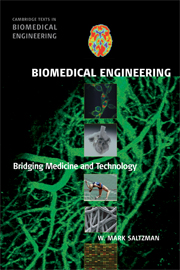Book contents
- Frontmatter
- Contents
- Preface
- Acknowledgments
- Abbreviations and Acronyms
- 1 Introduction: What Is Biomedical Engineering?
- PART 1 MOLECULAR AND CELLULAR PRINCIPLES
- PART 2 PHYSIOLOGICAL PRINCIPLES
- 6 Communication Systems in the Body
- 7 Engineering Balances: Respiration and Digestion
- 8 Circulation
- 9 Removal of Molecules from the Body
- PART 3 BIOMEDICAL ENGINEERING
- Appendix A Physiological Parameters
- Appendix B Chemical Parameters
- Appendix C Units and Conversion Factors
- Index
- Plate section
- References
6 - Communication Systems in the Body
from PART 2 - PHYSIOLOGICAL PRINCIPLES
- Frontmatter
- Contents
- Preface
- Acknowledgments
- Abbreviations and Acronyms
- 1 Introduction: What Is Biomedical Engineering?
- PART 1 MOLECULAR AND CELLULAR PRINCIPLES
- PART 2 PHYSIOLOGICAL PRINCIPLES
- 6 Communication Systems in the Body
- 7 Engineering Balances: Respiration and Digestion
- 8 Circulation
- 9 Removal of Molecules from the Body
- PART 3 BIOMEDICAL ENGINEERING
- Appendix A Physiological Parameters
- Appendix B Chemical Parameters
- Appendix C Units and Conversion Factors
- Index
- Plate section
- References
Summary
LEARNING OBJECTIVES
After reading this chapter, you should:
Understand the concept of affinity of a ligand for its associated receptor.
Understand the principle of signal transduction, and how signals can be activated by ligand binding to a receptor.
Understand the role of action potentials in signaling within the nervous system.
Understand how protein and steroid hormones provide circulating signals in the endocrine system.
Understand the diverse roles of signaling within the immune system.
Prelude
Chapter 5 provided background on the structure and function of human cells, which are the main functional units of the body. Most cells are fully independent living entities, capable of consuming nutrients, growing, and functioning autonomously. The human body is a collection of trillions of cells and, amazingly, these units act in a coordinated fashion, so that people can walk (usually without bumping into walls), breathe (without consciously motivating each breath), and kill invading pathogens (without knowing that they are there). How is the operation of all of these cells coordinated? This chapter reviews how cells communicate with each other directly and through signaling molecules to relay signals from outside and inside the cell (Figure 6.1).
Cells communicate with each other directly or indirectly via molecules called ligands. In direct cell–cell communication, the ligands are bound to the surface of the cell. Soluble, diffusible ligands are used for communication between cells that are not physically connected or are separated by long distances.
Information
- Type
- Chapter
- Information
- Biomedical EngineeringBridging Medicine and Technology, pp. 205 - 246Publisher: Cambridge University PressPrint publication year: 2009
